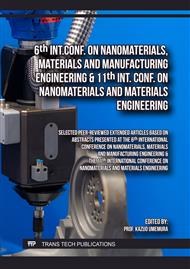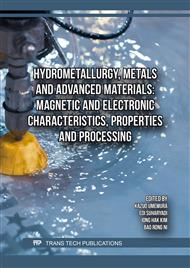[1]
R.L. Mason: Taguchi methods: a hands-on approach, J. Qual. Technol. Vol. 26 (1994), pp.77-78.
Google Scholar
[2]
T. Prakash, R. Ranjith, M. Sanjay and V. Sudharshan: Electric discharge machining of AZ91 magnesium hybrid composites under different dielectric mediums, Adv. Mater. Sci. Eng. Vol. 2022 (2022), pp.1-15.
Google Scholar
[3]
V. Reddy, P. Vikram, V. Madar, K. Adepu and Ch. Sridhar Reddy: Multi-objective optimization of electrical discharge machining of PH17-4 stainless steel with surfactant-mixed and graphite powder–mixed dielectric using taguchi-data envelopment analysis–based ranking method, Proc. Inst. Mech. Eng. Part B J. Eng. Manuf. Vol. 229 (2014), pp.487-494.
DOI: 10.1177/0954405414530904
Google Scholar
[4]
J. Chen, G. Lixu, X. Hanlin and Z. Wansheng: Study on blasting erosion arc machining of Ti–6Al–4V alloy, Int. J. Adv. Manuf. Technol. Vol. 85 (2015), pp.2819-2829.
DOI: 10.1007/s00170-015-8126-7
Google Scholar
[5]
Y.-F. Chen, L. Yufeng, S.-L. Chen and H. Li-Chang: Optimization of electro discharge machining parameters on ZrO2 ceramic using the Taguchi method, Proc. Inst. Mech. Eng. Part B J. Eng. Manuf. Vol. 224 (2009), pp.195-205.
Google Scholar
[6]
S. Habib: Parameter optimization of electrical discharge machining process by using taguchi approach, J. Eng. Technol. Res. Vol. 6 (2014), pp.27-42.
DOI: 10.5897/jetr2014.0356
Google Scholar
[7]
P.N. Huu, B.T. Long, T.D. Quy, P.V. Dong, N.X. Chung, N.V. Thien, N. Duc Luan et al.: Multi-objective optimization of process parameter in EDM using low-frequency vibration of workpiece assigned for SKD61, Sadhana Vol. 44 (2019), p.10.
DOI: 10.1007/s12046-019-1185-y
Google Scholar
[8]
G.S. Prihandana, M. Muslim, M. Hamdi and M. Kimiyuki: Effect of powder mixed dielectric fluid on surface quality and material removal rate in micro-EDM processes, Trans. Mater. Res. Soc. Japan Vol. 34 (2009), pp.329-332.
DOI: 10.14723/tmrsj.34.329
Google Scholar
[9]
G.S. Prihandana, M. Muslim, M. Hamdi and M. Kimiyuki: Effect of low-frequency vibration on workpiece in EDM processes, J. Mech. Sci. Technol. Vol. 25 (2011), pp.1231-1234.
DOI: 10.1007/s12206-011-0307-1
Google Scholar
[10]
P. Shrivastava and K.D. Avanish: Electrical discharge machining–based hybrid machining processes: a review, Proc. Inst. Mech. Eng. Part B J. Eng. Manuf. Vol. 228 (2013), pp.799-825.
Google Scholar
[11]
D. Singh: Optimization of electric discharge machining of al/al2o3 metal matrix composites using mopso, Int. J. Eng. Res. Mech. Civ. Eng. Vol. 9 (2022), pp.39-47.
DOI: 10.36647/ijermce/09.05.a007
Google Scholar
[12]
S. Srivastava, V. Mohit, T.G. Mamatha and K. Vikas: An insight on powder mixed electric discharge machining: a state of the art review, Proc. Inst. Mech. Eng. Part B J. Eng. Manuf. Vol. 237 (2022), pp.657-690.
Google Scholar
[13]
Y.P. Zeng, C.L. Lin, M.D. Hong, C.L. Yan and J. Hung: Multi-performance optimization in electrical discharge machining of Al2O3 ceramics using Taguchi base AHP weighted TOPSIS method, Processes Vol. 9 (2021), p.1647.
DOI: 10.3390/pr9091647
Google Scholar
[14]
M. Akgun: Performance analysis of electrode materials in electro discharge machining of monel K-500, Surf. Topogr. Metrol. Prop. Vol. 10 (2022), p.035026.
DOI: 10.1088/2051-672x/ac8d19
Google Scholar
[15]
P. Sivaprakasam, P. Hariharan and S. Gowri: Modeling and analysis of micro-WEDM process of titanium alloy (Ti–6Al–4V) using response surface approach, Eng. Sci. Technol. Int. J. Vol. 17 (2014), pp.227-235.
DOI: 10.1016/j.jestch.2014.06.004
Google Scholar
[16]
K. Ishfaq, A. Mohammed, A. Saqib, I.P. Catalin and S. Mustafa: A comprehensive analysis of the effect of graphene-based dielectric for sustainable electric discharge machining of Ti-6Al-4V, Mater. Vol. 14 (2020), p.23.
DOI: 10.3390/ma14010023
Google Scholar
[17]
R. Khanna, K. Anish, P.G. Mohinder, P.S. Ajit and S. Neeraj: Multiple performance characteristics optimization for Al7075 on electric discharge drilling by Taguchi Grey relational theory, J. Ind. Eng. Int. Vol. 11 (2015), pp.459-472.
DOI: 10.1007/s40092-015-0112-z
Google Scholar
[18]
W. Ming, Z. Guojun, L. He, G. Jianwen, H. Yu and C. Zhi: A hybrid process model for EDM based on finite-element method and gaussian process regression, Int. J. Adv. Manuf. Technol. Vol. 74 (2014), pp.1197-1211.
DOI: 10.1007/s00170-014-5989-y
Google Scholar
[19]
K. Gupta: Intelligent machining of shape memory alloys, Adv. Sci. Technol. Res. J. Vol. 15 (2021), pp.43-53.
Google Scholar



